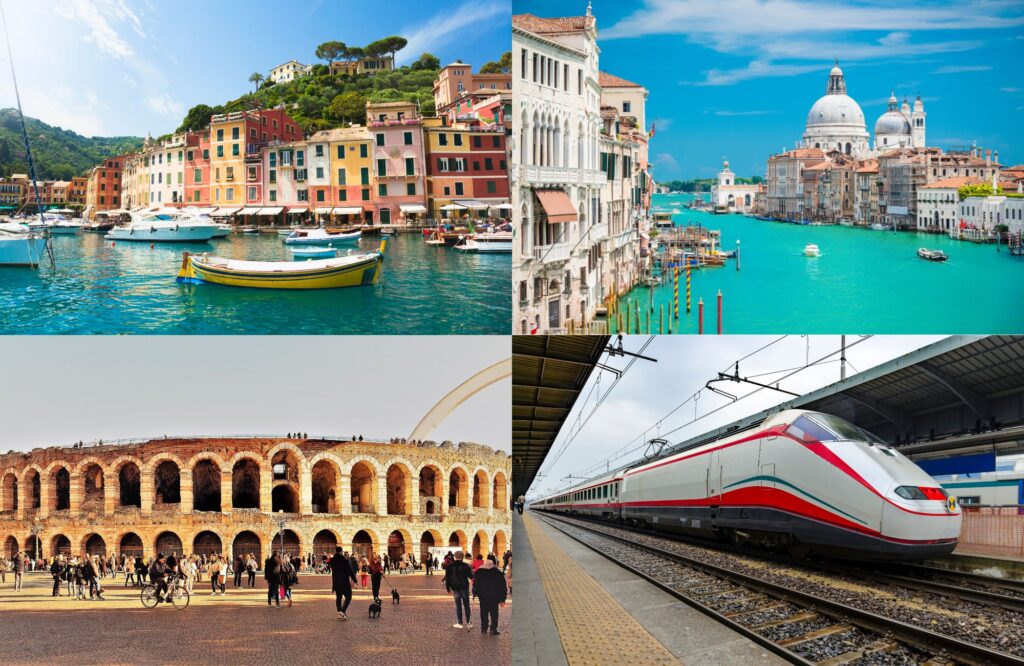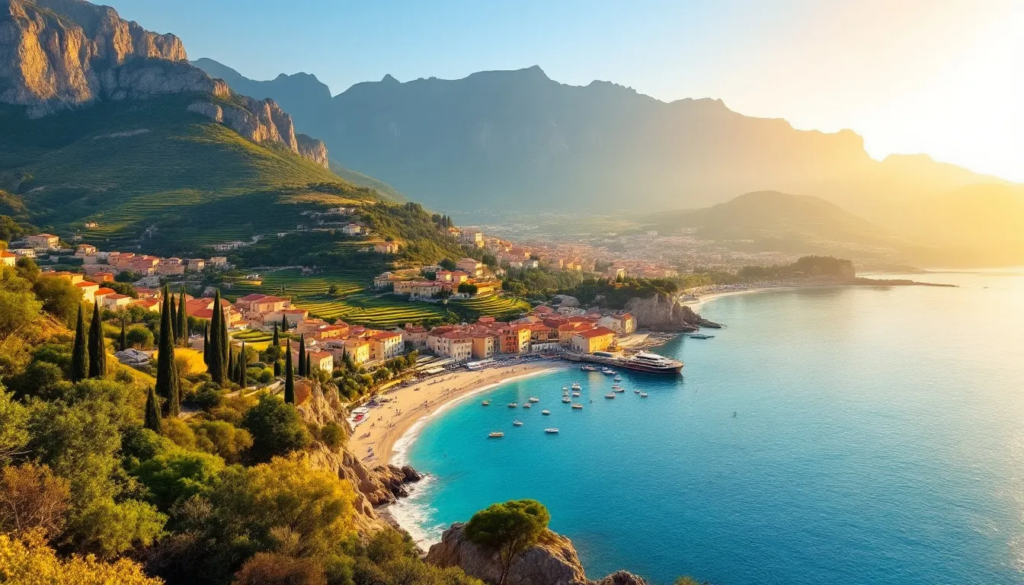Italy is one of the most beautiful and diverse countries in Europe, and getting around it is part of the adventure. From the sweeping vineyards of Tuscany to the hilltop towns of Le Marche and the rugged coastlines of Sicily, the transportation you choose will shape your experience. The good news is that Italy has an extensive network of trains, buses, highways, airports, and ferry routes that connect even the smallest towns to the country’s major cities.
This guide will show you how to travel within Italy using every major mode of transport, from high-speed trains and rental cars to public buses and ferries. Whether you’re trying to get from Rome to Venice or planning a countryside escape, understanding your options will help you save time, money, and hassle.
Overview of Transportation Options in Italy
Italy offers a wide range of transportation options to suit different travel styles, budgets, and itineraries. Some routes are best served by train, others require a car, and in some cases, buses or ferries are the most efficient way to explore.
To help you compare the pros and cons, here’s a quick breakdown:
| Transport Mode | Best For | Avg. Cost (One Way) | Speed | Regions Covered |
|---|---|---|---|---|
| High-speed trains | Intercity routes, main cities | $30–60 | Fast | All major Italian cities |
| Regional trains | Local connections, smaller towns | $5–20 | Medium | Rural + suburban regions |
| Rental cars | Countryside, Le Marche, Tuscany | $40–70/day | Variable | All areas (with road access) |
| Intercity buses | Budget-friendly long-distance travel | $10–35 | Medium | Cities and towns |
| Public transport | Urban centers, daily commuting | $1.50–2 per ride | Slow | Most Italian cities |
| Domestic flights | Long distances (e.g., north-south) | $50–90 | Fast | Key airports (Rome, Milan) |
| Ferries | Islands, coastal towns | $20–50 | Medium | Amalfi, Sicily, Sardinia |
Each option has its trade-offs, but combining transport modes (e.g., train + ferry or car + bus) often gives you the best experience.
Traveling by Train – Fast, Easy, and Scenic
The Italian train system is one of the most convenient ways to travel between cities. Most Italian trains are punctual, clean, and well-connected across the peninsula. High-speed trains like Frecciarossa, Frecciargento, and Italo trains serve major cities including Rome, Florence, Milan, Bologna, Naples, and Venice. These high-speed services can reach up to 300 km/h and offer both standard and business-class seating.
Tickets can be booked online, at a ticket office, or using digital kiosks. It’s advisable to book high-speed tickets in advance to get the best deals and secure seat reservations. Regional trains, on the other hand, don’t require reservations and are great for day trips to picturesque towns like Orvieto, Assisi, or Ancona.
While train travel in Italy is generally efficient, be mindful of peak commuting hours, which can affect availability on regional and intercity trains. Also note that smaller stations might not sell tickets, use a mobile app, or buy at a larger hub before you travel.
Renting a Car – Freedom to Explore the Countryside
While trains are excellent for getting between major Italian cities, renting a car gives you access to smaller towns and off-the-beaten-path destinations. This is especially valuable in regions like Le Marche, Tuscany, or southern Italy, where public transportation is limited or infrequent.
To rent a car in Italy, you’ll need a valid driver’s license and often an International Driving Permit (IDP). Most car rental companies require drivers to be at least 21 years old.
Driving in Italy can be a joy, but also a challenge. You’ll encounter narrow roads, traffic congestion in urban areas, and ZTL zones (restricted access in many city centers). Parking can be expensive in historic districts, so it’s best to leave your car or rental on the edge of town and walk.
Fuel costs are higher than in many European cities, and some roads require tolls. However, the flexibility of having your vehicle means you can stop at farm stays, wineries, or hilltop towns with stunning sights that aren’t on any rail map.
Buses and Coaches – Budget-Friendly Regional Access
If you’re traveling between various Italian cities on a budget, long-distance buses are a reliable and cost-effective option. Providers like FlixBus, Itabus, and MarinoBus offer routes between most major hubs and even some lesser-known destinations.
While slower than train travel, buses often depart from central locations and may reach towns that lack train stations. Ticket prices are usually lower than national trains, especially when booked in advance.
Local buses also operate within cities and towns, offering connections to nearby attractions or outlying neighborhoods. Tickets can be purchased at tabacchi shops, kiosks, or directly on board (sometimes with a small surcharge). Timetables and bus routes can vary, so it’s wise to check schedules online or through regional apps.
If you’re planning to explore urban centers or main cities, be prepared for buses to get crowded during rush hour. Still, they remain one of the most widely used and efficient services for short distances.
Domestic Flights – Quick Connections Between Distant Regions
Italy’s north-to-south distance can make domestic flights an efficient option, especially for those short on time. While high-speed trains cover many major routes, flights are ideal for traveling between cities like Milan and Palermo or Venice and Catania.
Low-cost airlines such as Ryanair, ITA Airways, and Volotea offer internal flights at competitive prices. Booking in advance usually ensures the best deals, though baggage fees may add up. Keep in mind that most airports are located outside city centers, requiring additional time and local transport.
Use flights selectively; for trips under 4 hours, by rail, trains are often faster overall when accounting for airport transfers and security lines.
Ferries and Coastal Travel – Explore Italy by Water
Italy’s coastline is dotted with ferry terminals that connect mainland cities with islands and smaller towns along the shore. Ferry services are a scenic and relaxing way to travel, particularly in coastal areas like the Amalfi Coast, Cinque Terre, Sardinia, and Sicily.
Major ferry operators include Tirrenia, SNAV, Moby, and NLG. These companies sell tickets online or at ferry terminals, and many offer the option to bring your car onboard.
Ferries are seasonal, with more frequent departures in spring and summer. Travelers visiting island destinations during shoulder seasons should plan, as service can be reduced or paused entirely.
Sample Itineraries Using Different Modes of Transport
Planning your transport around your destination helps balance cost, comfort, and time. Here are three example itineraries that show how different modes work together:
1. Classic City Tour (Train Only)
- Route: Rome → Florence → Venice
- Mode: High-speed trains (Frecciarossa / Italo)
- Duration: 6–8 days
- Ideal for: First-time visitors, history lovers
2. Countryside Escape (Car + Ferry)
- Route: Ancona → Ascoli Piceno → Conero Coast
- Mode: Rental car + short ferry ride
- Duration: 5–7 days
- Ideal for: Slow travelers, families, wine lovers
3. Southern Loop (Flight + Local Bus)
- Route: Palermo → Naples → Amalfi
- Mode: Domestic flight + regional buses
- Duration: 7–10 days
- Ideal for: Beachgoers, food travelers
Each example offers different perspectives on how to travel within Italy based on priorities like speed, price, or access.
Tips for Choosing the Right Mode of Transport
When deciding how to travel, consider your destination, budget, and personal travel style. Trains are great for covering long distances between cities, while rental cars are best for rural routes and flexible schedules. Buses and ferries offer more niche access but can be perfect for certain regions.
Here are a few factors to help you decide:
- Trip Length: Shorter stays favor high-speed trains or flights; longer ones allow slower scenic routes
- Group Size: Rental cars are cost-efficient for 3–4 people
- Comfort vs Budget: Trains and private transfers cost more but offer ease
- Luggage: If you’re packing heavy, trains and cars are better than buses
For areas like Le Marche or Umbria, combining a train to the nearest city with a local driver or private company transfer often makes the most sense.
Conclusion
Traveling within Italy offers a range of options to fit different needs and budgets. Whether you’re using high-speed trains between major cities, renting a car to explore smaller towns, or taking a ferry along the coast, each mode of transport has its advantages. With some planning, you can choose the right combination to match your itinerary, travel style, and pace. Italy’s transport network makes it possible to move comfortably between well-known destinations and lesser-known regions.
Want to explore Italy beyond the typical tourist paths? At True Colors of Italy, we offer private, all-inclusive day tours through the heart of Le Marche, where rich history, local flavors, and stunning landscapes come together. Whether you’re traveling solo, as a couple, or with a small group, our curated experiences are crafted for those who appreciate authenticity and thoughtful planning.
Contact us today to begin your personalized journey through Italy’s hidden treasures.
FAQs
What is the best way to travel around Italy?
The best way to travel around Italy depends on your itinerary. High-speed trains are ideal for traveling between major cities, while rental cars give more freedom in rural areas. Buses and ferries are excellent budget-friendly alternatives for certain regions and coastal towns.
What’s the cheapest way to travel through Italy?
The cheapest way to travel through Italy is by using regional trains and long-distance buses like FlixBus or Itabus. Booking in advance can cut costs significantly. Avoid taxis and peak-hour travel in major cities to keep expenses down.
Is it expensive to travel within Italy?
Traveling within Italy can be affordable with proper planning. Regional train services and local buses are budget-friendly, and off-peak tickets for high-speed trains offer savings. Renting a car or flying domestically may increase costs but offer added convenience.
How to travel independently in Italy?
Independent travel in Italy is easy thanks to a well-connected transportation system. Use high-speed and regional trains for most routes, and supplement with local buses, car rentals, or ferries for remote or scenic areas. Planning routes in advance ensures flexibility and cost control.












